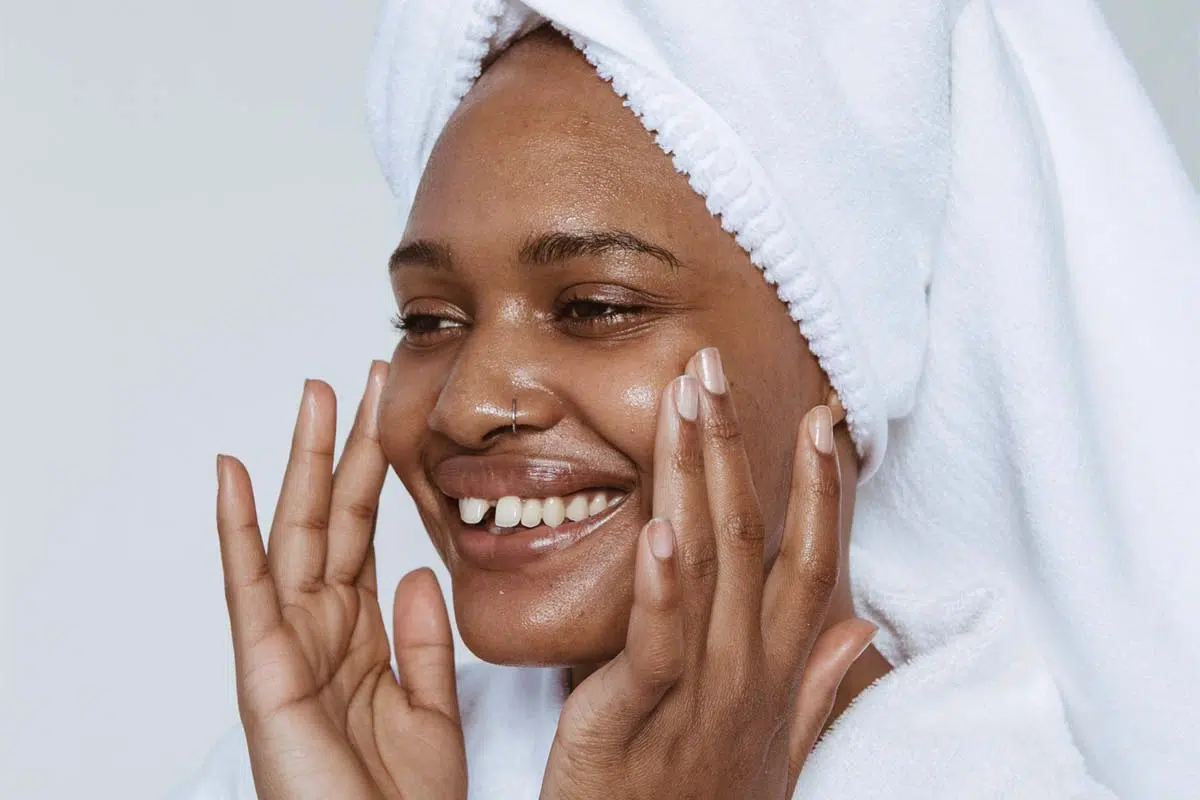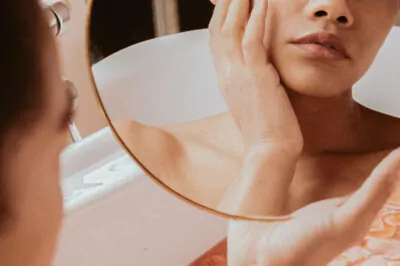Table of Contents[Hide][Show]
In the world of skin care, few questions spark more curiosity than this one: what’s the difference between a moisturizer and a serum? Both make your skin feel nourished, but they serve very different roles. So, can you use a serum instead of a moisturizer? And if you need both, what goes on first—serum or moisturizer?
It might seem like a small detail, but the order of application can make a real difference in how your products perform. Layering correctly helps your ingredients absorb more effectively and keeps your skin balanced and radiant.
In this guide, we’ll share the essential, esthetician-approved method for layering, explore the difference between hydrating serums vs. moisturizers, and explain why this time-tested, science-inspired approach helps you get the most from every step. Think of it as a ritual—guided by both nature and science—that lets each formula perform its best, delivering maximum results for your skin.
The Core Difference: A “Drink of Water” vs. a “Protective Coat”

The easiest way to understand the difference between a serum and a moisturizer is to think of their primary jobs, which are rooted in their unique molecular structures. A serum’s main job is to hydrate, while a moisturizer’s main job is to moisturize. While they sound similar, in the world of skin science, they are two very different and equally crucial actions.
Serums Deliver Hydration (The “Drink of Water”)
A serum is designed with a lightweight, aqueous-based formula that allows it to penetrate deeper into the skin’s layers, delivering a concentrated dose of active ingredients where they’re needed most. These actives—like hyaluronic acid, saccharide isomerate, bioactive A-complex, or vitamin C—are what give serums their powerful, skin-boosting benefits, helping to hydrate, brighten, and rejuvenate from within. A beautiful example is a serum containing humectants like the Tremella mushroom, found in our Probiotic Serum With Tremella, which pulls moisture deep into the skin for a plump, dewy look from within.
Moisturizers Provide Moisture (The “Protective Coat”)
A moisturizer, on the other hand, is typically an oil or richer cream composed of larger molecules. It may be purely oil or an emulsion of both water and oil, and its main job is to work on the skin’s surface. While moisturizers that contain both hydrating and moisturizing ingredients can provide some hydration, its most critical role is to condition the skin by creating a nourishing, protective barrier on top. This lipid barrier acts like a “protective coat,” locking in all the deep hydration from your serum and preventing it from evaporating into the air. It also keeps your skin feeling soft and supple. A Rejuvenating Facial Oil or comforting cream like our Restorative Facial Cream is a perfect example of a product that performs this essential sealing function.
The Essential Order: Serum Always Goes First

Now that you understand their very different jobs and molecular sizes, the correct layering order becomes simple, scientific, and intuitive. The essential rule of layering is to apply your products in order of texture, from the thinnest to the thickest. This generally corresponds to applying products with the smallest molecules first, followed by those with the largest.
Because your serum is a lightweight, water-based liquid made of very small molecules, it must be applied to clean skin first. This ensures it has a clear and unobstructed pathway to be absorbed and to deliver its potent ingredients deep into the skin where they work best. Applying a thick cream or a rich facial oil with large molecules first would be like trying to water the roots of a plant after laying a tarp over the soil; you would create an occlusive barrier that blocks your serum’s small molecules from ever reaching their destination.
Can a Serum Replace Your Moisturizer?

This is one of the most common questions we hear, and the definitive answer is no: for most skin types, a serum does not replace a moisturizer. They are partners, not competitors, designed to work as an essential team. When you apply a hydrating serum without sealing it in with a moisturizer, much of that moisture can quickly escape through a natural process called transepidermal water loss—leaving your skin feeling dehydrated again soon after. You need both the deep-diving “drink of water” (your serum) and the surface-level “protective coat” (your moisturizer) for a complete routine.
This partnership is crucial even for those with oily skin. It’s a common myth that oily skin doesn’t need moisturization, but often, excess oil is a sign of dry skin overproducing sebum to compensate. By using a facial oil suited for your skin type (like the Herbal Facial Oil for Oily Skin), your skin gets the moisturization it craves without over or underwhelming it. Simply apply your desired serum, then follow with your skin type’s best moisturizer.
Choosing Serums for Your Specific Goals
The true beauty of incorporating serums into your routine is the power of customization. Because each serum is a specialist, you can choose a formula that directly addresses what your skin is asking for in any given season or stage of life.
For a Brighter, More Radiant Look
If your primary goal is to address the look of dullness or an uneven skin tone, a serum rich in antioxidants from ingredients like fruit-powered Vitamin C is a powerful and effective choice. These potent botanicals help support the skin against daily environmental stressors that can diminish its natural glow. Our Wild Fruit Serum is a concentrated botanical complex specifically designed to promote a luminous, vibrant-looking complexion.
For Age-Supportive Benefits
To soften the appearance of fine lines and promote a firm, youthful look, look for serums with targeted, skin-renewing ingredients. Many people are now discovering the power of gentle yet effective plant-based retinol alternatives that offer visible results without the common irritation associated with traditional retinol. Our Activated Night Serum, featuring non-toxic retinol alternative, bioactive A-Complex, is a perfect example, crafted with this exact philosophy to support the skin’s natural renewal process while you sleep.
The Power of Partnership in Your Routine
The key takeaway is beautifully simple: serums and moisturizers are a non-negotiable team. They are designed to work in perfect partnership. Your serum goes deep to deliver that targeted, potent “drink of water,” while your moisturizer works on the surface to lock it all in, nourish, and protect your skin’s delicate barrier.
We encourage you to embrace this powerful duo in your daily ritual. By understanding and honoring their different roles and layering them correctly, you are giving your skin the complete, holistic support it needs to look and feel its absolute best. It’s one of the simplest and most profound ways to elevate your routine from basic maintenance to an act of true, effective self-care.
Ready to find the perfect specialist for your skin? From brightening to hydrating to age-supportive, our formulas are designed to deliver potent, plant-based results. We invite you to explore our full Serums & Elixirs collection to discover your skin’s new best friend.
Frequently Asked Questions
How long should I wait between applying my serum and moisturizer?
A good rule of thumb is to wait about 60 seconds. This isn’t a strict rule, but it gives the serum a moment to begin absorbing into the skin, creating a perfect canvas before you apply your moisturizer on top.
Does this rule apply to facial oils too?
Yes, the “thinnest to thickest” rule is universal. A facial oil is generally even richer and more occlusive than a moisturizer, so it should be the final step in your routine to seal everything in. However, you don’t necessarily need to wait 60 minutes between your cream and oil—you could mix the two together if you prefer a finish that combines the best of both worlds. You can learn more in our complete guide to the differences between a facial oil and a moisturizer.
How do I know which serum is right for my skin?
Choosing the right serum is a beautiful journey of listening to your skin’s unique needs and goals. To help you navigate the options and understand which ingredients will serve you best, we’ve created a complete guide on how to choose your face serum.







Leave a Reply